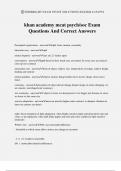©THEBRIGHT EXAM STUDY SOLUTIONS 8/22/2024 12:54 PM
khan academy mcat psych/soc Exam
Questions And Correct Answers
Perceptual organization - answer✔✔depth, form, motion, constantly
binocular cues - answer✔✔depth
retinal disparity - answer✔✔eyes are 2.5 inches apart
convergence - answer✔✔depth based on how much eyes are turned, far away eyes are relaxed,
close up eyes contract
monocular cues - answer✔✔form of object, relative size, interpositoin (overlap), relative height,
shading and contour
motion parallax - answer✔✔relative motion, things farther move slower, things closer move
faster
constancy - answer✔✔perception of object doesnt change despite image on retina changing, we
are smarter, size/shape/color constancy
size constancy - answer✔✔if object is closer we dont perceive it as bigger just because its close,
we know its the same size
sensory adaptation - answer✔✔inner ear muscle (higher noise contract, to dampen vibration in
inner ear, protect ear drum)
sight: down regulation of light adaptation, when bright constrict pupils and desensitize rods and
cones, or up regulatoin, when dark dilate pupils and rods and cones synthesize light sensitive
molecules
Weber's law - answer✔✔JND= just noticeable difference
- threshold at which youre able to notice any change in sensation
- 2 vs. 2.2 weight is noticeable
dI= .1 (noticeable intensity difference)
, ©THEBRIGHT EXAM STUDY SOLUTIONS 8/22/2024 12:54 PM
linear relationship betwen threshold and intensity
I vs. dI= linear
absolute threshold of sensation - answer✔✔differences based on the individual
minimum intensity of stimulus needed to detect a particular stimulus 50% of the time
influenced by expectations, experience, motivation, alertness
subliminal stimuli - answer✔✔stimuli below the absolute threshold of sensation
somatosensation - answer✔✔intensity, timing, location
temp, pressure, pain, position
intensity - answer✔✔how quickly the neurons fire
timing - answer✔✔non-adapting= constant firing rate, temp
slow-adapting= neuron fires in beginning and calms down after a while, pressure/pain
fast-adapting= fires as soon as stimulus starts then stops firing then starts again when the simulus
stops, proprioception, and some pain
vestibular system - answer✔✔balance and orientation
inner ear= semicircular canals (posterior, lateral, anterior)
filled with endolymph to detect motion of the fluid with rotation
otolithic organs= utricle and saccule, detect linear acceleration and head positioning, calcium
carbonate crystals attached to hair cells in viscous gel, when we move they pull on hair cells and
trigger AP, depend on gravity!
, ©THEBRIGHT EXAM STUDY SOLUTIONS 8/22/2024 12:54 PM
dizziness and vertigo
Signal Detection Theory - answer✔✔how we make decision under conditions of uncertainty,
discern between importnat stimuli and unimportant "noise"
ex. if given 2 lists in psych experiment and then person asks which words came from first list,
they would be uncertain
or traffic light in the fog and can't tell
type I error - answer✔✔false positive
type II error - answer✔✔false negative
d' - answer✔✔*dick is strong= strength
hit>miss when there is a strong signal
miss > hit when there is a weak signal
c' - answer✔✔C= strategy
Celeste is always conservative
always say no unless you are 100% sure the signal is present
might get some misses
liberal strategy= always say yes even if you get false alarms
signal detection theory pt 2 - answer✔✔"noise" distribution and signal distribution
the difference between the 2 is d'
, ©THEBRIGHT EXAM STUDY SOLUTIONS 8/22/2024 12:54 PM
if signal shifted to the R, d' would be big and easy to detect
strategy C expressed via choice threshold
Beta= set value of threshold, ratio of height of signal distribution to height of noise distribution
bottom-up processing - answer✔✔begin with stimulus, data driven, always correct, inductive
reasoning
no preconceived cognition constructs of the stimulus (never seen it before)
top-down processing - answer✔✔use background knowledge to influence perception, ex. where's
waldo
theory driven, deductive reasoning
ex creating a cube image when its not there based on the tricky image
gestalt principle - answer✔✔items similar to one another are grouped together
things are reduced to their simplest form possible
ex. brain organizes them into columns of circles and squares
objects close physically together are grouped together
continuity, smooth lines
closure, objects grouped together are seen as a whole




